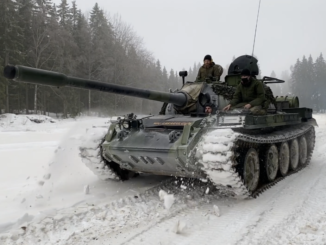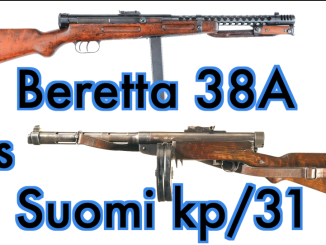The m/44 pistol was intended to be a lower-cost replacement for the Lahti L35 pistol for the Finnish Defense Forces, but production delays resulted in the first batch of 25 examples not being completed until after the end of the Continuation War. Treaties limited Finland’s right to conduct arms development after the war, and the project was never taken farther than that first batch.
Mechanically, the pistol is a simple blowback 9x19mm pistol, with a single stack 8-round magazine, single action trigger, and external hammer. The barrel locking system is very reminiscent of the Ruby and Browning fixed barrel pistols, and the fire control parts are contained in a removable unit like a Tokarev. Production was done at VKT, the Finnish state rifle factory in 1944.




“(…)m/44(…)”
Its description can be found here: https://www.jaegerplatoon.net/ALMOST2.htm in chapter titled 9 mm military pistol M/44. Interestingly it was designed by Colonel-Lieutenant Birger Linkomies. I am wondering if similar task was proposed Aimo Lahti [designer of then-default automatic pistol of Finnish forces]? Independently from formal bans, testing m/44 showed cartridge cases tended to expand which leads me to doubt about its safety after firing several cartridges. Finish estimates from 1943 were that 14850 examples would be required, which leads to me wondering why they did not buy suitable automatic pistols from Germans (in 1943 ally of Finland)?
Germany needed most all of its own weapons production. But the finns could have bought in Spain e.g. The Astra 400 is nearly the same in layout.
A couple of simple guesses why Finland didn’t buy pistols from Germany in ’43:
– Finland needed other stuff more than pistols and scarse funds were used where most needed.
– Germany needed pistols themselves and maybe they didn’t offer the Finns such models that the Finns wanted. Finland did use FN High Powers manufactured by Germany in Belgium, especially the Air Force used them and the Finnish Tank Brigade did use CZ made pistols delivered by Germany. Btw, check out Ruben Lagus, it would have been interesting what he might have achieved with better equipment than the war booty the Finns did use. Regardless of the equipment, their Tank Brigade did perform extremely well, their best equipment being German Sturms Ausf III and war booty T-34s.
-Finland and Germany weren’t the closest friends, it was a companionship by necessity having a common enemy in the east. For example, Mannerheim was pro-British.
An interesting fact, Germans in Finland did salute Finnish officers that were Jewish and took orders from these officiers if they operated together, in fact 3 Finnish Jews were awarded the Iron Cross by the Germans !
I guess that the question arises of what loading gave the bulged cases?
And we’re they concentrically bulged, indicating too slack and chamber, too light a slide (unlikely), or too much chamfering of the chamber mouth?
Or bulged into the feed ramp?
It’s interesting that Swedish forces used Browning blowbacks both before and after the Lahti M40.
“Swedish forces used Browning blowback(…)after(…)M40.”
According to http://gotavapen.se/gota/m07/pist07_4.htm it was caused by introduction of more powerful version of 9×19 Parabellum for usage in sub-machine gun:
The story [of m/07] should be over 1942 when the Finnish pistol Lahti Swedish m/40 started to be produced in large numbers. This was not the case, because when Sweden accepted the heavy armour piercing submachine gun cartridge 9 mm called m/39b (with red seal), the m/40 could not stand the heavy submachine gun ammo.
Regarding the equipment of the Finnish Army after armistice:
The Finnsh Army did hide away a lot of weaponry and supplies around the country and had everything ready for resisting the Russians in case they had done the same as in Romania. The Russians did learn about these preparations and were probably not too happy knowing that they might face organized, battlehardened veterans in a guerilla war. Still today they do find caches of these arms hidden away. Of all countries involved in WW2 in Europe, only 3 capitals were never occupied by foreign troops, London, Moscow and little Helsinki.
“A Finn is worth a thousand Russians!” -lots of shooting later, a single Russian stumbles out of the woods. “Don’t send anyone else, it’s a trick. There are two of them in the woods!” Sure, Russia got to keep the contested real estate, but that came at a very steep price hike in terms of people and materiel (darn lack of accent marks on mobile devices). I think Stalin got ripped off, Finland basically sold the area and used the weapons, ammunition, tanks, and planes they captured as payment. To paraphrase a Russian officer, “we got short end of stick, as gained land is only enough to bury the dead. They got enough planes for two air forces, and enough rifles for two armies…” yes, I’m just joking.
I get your point, of course. Just to nit-pick: What about Sofia, Bulgaria? I mean, yes, Soviet troops entered the capital, but did so at the point that Bulgaria had rather precipitously switched sides, no?
Like Romania, Finland had to attempt to eject the Germans as part of the post-armistice deal… such that the Germans burned everything in Lapland. Finland was fortunate indeed in that it was the only state sharing a border with the USSR that was not incorporated into a Warsaw Pact buffer state… But on the other hand, it required some rather delicate, “fancy footwork” by the politicos, no?
Finland was lucky that it did not stay in the way of Soviet “drang nach western” policy.
They had no strategic goal of pushing through them towards Sweden and Norway, but with other slavic countries they “liberated” like Poland or Czech/Slovakia it was different situation…
They resisted soviets in Winter War and shown that they would be tough to conquer, if they just let Soviets march in and take whatever land they want or destroy their republic and install a puppet, pro Soviet one, Soviets would surely do it.
Good one, London. Got a chuckle.
lnteresting pistol. Seemingly barrel taken out needs the removable breechbolt disassamble first and the extractor should be the key piece to accomplish this.
Fascinating. Looks an awful lot like the Polish WANAD P83 9x18mm service pistol, no? Of course that has positively SIG-style de-cocking lever and whatnot…
Interesting blend of the Eibar-Basque Ruby–simplified production–Soviet Tula Tokarev–one of the best, if not the best pistols of WWII–and the Spanish Astra Modelo 1921 (400) in 9mm largo. Way better looking and somehow more “finished” (Finnished?!) than the comparable German Volkspistole prototypes for the pistol-heavy German armed forces.
Of course Finland had Ruby pistols, captured Soviet Tokarevs, .30 and 9mm cal. Lugers, 9mm Lahti 1935s, Nagant gas-seal 7.62mm 7-shooters, FN 1910s, the Swedish volunteers apparently brought a handful of the 9mm Browning SR long model 1903/07s, a handful of Browning HPs, some WWI-era Italian .32s, some .380 Beretta m/34s and .32 acp m/35s, the aforementioned .380 Czech vz24/m/23s–basically a warmed over Mauser M1914 in a better caliber, some .380/9mm kurz CZ 38 DAO m/39s, and a truly bewildering assortment of German WWI-era .32…
“(…)Soviet Tula Tokarev(…)”
Interestingly, also in Leningrad blow-back automatic pistol for then-default i.e. 7,62×25 mm was developed, namely Балтиец, see photos: http://oruzhie.info/pistolety/748-baltiets
only 14 examples were completed, they were heavily Walther PP-inspired and worked satisfactorily but were deemed too heavy.
“(…)Tokarev–one of the best, if not the best pistols of WWII(…)”
Nonetheless after Soviets produced limited quantity (around 1500) of Voyevodin automatic pistols with 18-round magazine and exposed barrel (see photos: http://www.iz-article.ru/voevodin_6.html ) F.V.Tokarev was working on crucially improving TT-33 design, which resulted in 7,62-mm 15-shot Tokarev pistol, it was produced but in very limited quantity (around 1000 examples), see 3rd xor 4th xor 5th photo from bottom there: http://historypistols.ru/blog/pistolety-pod-unitarnyj-patron-avtomaticheskie/opytnye-obrazcy-pistoletov-tokareva/
15-shot variant differed in that it was fatter (width 42 mm) and has different magazine release.
Interestingly TT-33 also spawned Type 54 automatic pistol which then spawned another high-capacity automatic pistol which was produced on bigger scale namely K14-VN:
https://modernfirearms.net/en/handguns/handguns-en/vietnam-semi-automatic-pistols/k14-vn-eng/
with 13-round magazine.
Interesting Vietnamese variant. Of course, the Vietminh and later Peoples Army obtained huge numbers of Shpagin PPSh-41 SMGs, including Chi-com Type 50s and the “real deal.” Apparently the collapsing stock and other features of the French 9mm MAT-49 were preferred–compactness would be an important virtue in “guerre clandestine” or guerrilla warfare of course. The result was the K-50, where the Shpagin gets a pistol-grip, a shortened barrel jacket, a collapsible wire stock, and a few other tweaks.
Those high-cap. Tokarevs and other prototypes must surely have had some impact on the development of the APS Stechkin, no?
Porfirio Díaz, dictator of Mexico, is attributed the quote: “pobre Mexico, tan lejos de Díos, tan cerca de los Estados Unidos…” or, poor Mexico, so far from God, so close/too close to the United States… I suppose Finland’s experiences between the great powers Sweden (before the mid-1700s anyway…), Germany, and Russia must surely be similar.
If the Finnish armed forces arrived at the “Peltiheikki” 9.00 konepistooli m/44 earlier and taken all those .32s and melted ’em down for sheet metal to make more 9mm burp guns… Far more capable than any handgun/pistol, certainly!